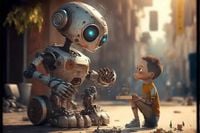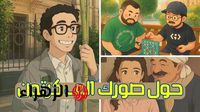In recent weeks, images inspired by Studio Ghibli and generated through artificial intelligence have taken the internet by storm, prompting a notable reaction from Sam Altman, CEO of OpenAI. He acknowledged that some AI-generated images appeared 'fake,' leading the company to work on improving the service. However, rather than being deterred, users have begun to embrace a new trend: creating personalized animated characters using ChatGPT's drawing capabilities.
This trend resonates deeply with millions who grew up with iconic characters like Barbie, Jay-Z, and He-Man. Now, they can use AI to recreate these beloved figures in a way that reflects their own creativity. With the ability to generate unique animated characters, users are finding new avenues for self-expression and nostalgia.
To create any image using artificial intelligence via ChatGPT, users first need to have an account. For those interested in generating an unlimited number of images, subscribing to 'ChatGPT Plus' is necessary. This paid plan, which costs around $20 per month, grants access to advanced AI models and the functionality to create a variety of images.
Here’s how to create a personalized animated character using ChatGPT:
- Open a ChatGPT account.
- Upload your personal photo.
- Use a prompt requesting the AI to design animated characters inspired by your likeness.
- Customize further by adding your name, selecting colors, and including accessories as desired.
- Click 'Enter' and watch as the AI generates your character within seconds.
As Studio Ghibli images flooded social media over the past few weeks, questions emerged regarding the legitimacy of using such artistic works, which often touch on copyright issues. This has led many to view the creation of animated characters through AI as a safer and less controversial option.
Social media users have quickly jumped on this new trend, sharing their creations and experiences. The excitement around this technology is palpable, with many eager to showcase their unique characters to friends and followers.
In a significant development, OpenAI announced that it would provide free access to the 'ChatGPT Plus' plan for university students in the United States and Canada until the end of May 2025. This initiative aims to expand access to advanced AI capabilities, which could further fuel creativity among students. The move is seen as a way to democratize access to cutting-edge technology, allowing more individuals to engage with AI in innovative ways.
Meanwhile, converting images to anime has emerged as another popular application of AI technology. This process allows users to transform their regular photos into stunning anime-style drawings with relative ease. The growing interest in such tools reflects a broader trend of integrating AI into artistic endeavors, making it accessible to a wider audience.
Converting images to anime involves using AI algorithms that analyze facial features, colors, and other details to produce a drawing that mimics the style of Japanese anime. This process not only showcases the capabilities of AI but also highlights the creative potential of users who are eager to experiment with their images.
Here’s how to convert your photo into anime using ChatGPT:
- Utilize the AI tool within ChatGPT that supports image adjustments, including anime conversion technologies.
- Upload your image and request a conversion into anime style.
- Before conversion, specify your preferred anime style, whether it be classic like Studio Ghibli or modern like "Demon Slayer."
- After conversion, you may need to enhance the image further using editing software such as Photoshop or other AI applications.
- Finally, save and share your anime image on social media or use it as a unique profile picture.
In addition to ChatGPT, there are several alternative tools available for converting images to anime, including DeepAnime, ToonMe, and VanceAI Toongineer Cartoonizer. These tools provide users with various options to achieve their desired artistic effects.
For those looking to get the best results from their anime conversions, here are some tips:
- Use high-quality images to ensure clear details in the final product.
- Experiment with different anime styles to find the one that suits you best.
- Ensure proper lighting in the original image for a more accurate transformation.
The intersection of AI technology and creative expression is rapidly evolving, with tools like ChatGPT leading the way in making artistic endeavors more accessible. As users continue to explore these innovations, the potential for creativity seems boundless.
As this trend grows, it will be interesting to see how the landscape of digital art continues to shift, driven by user creativity and the capabilities of AI.



